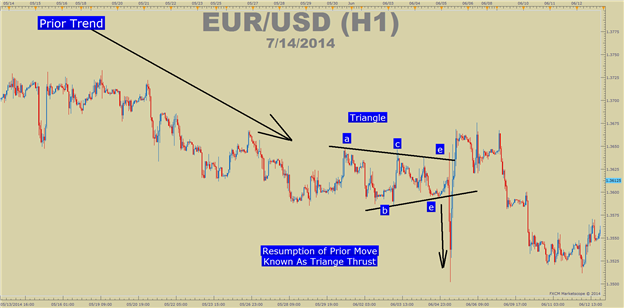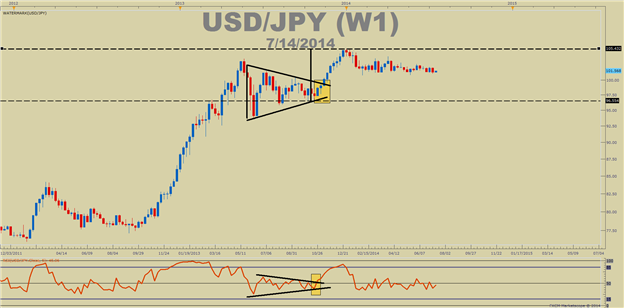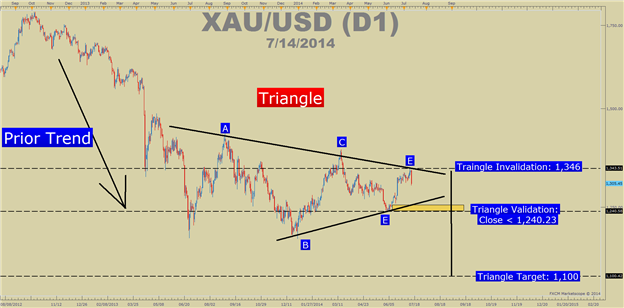Pre-Trend Chart Patterns Every Trader Should Know: Part II
by
, 07-23-2014 at 04:07 AM (1953 Views)
Talking Points:
- Recap of the Zig-Zag & The Study of Corrections
- The Second Pre-Trend Pattern: Triangles
- Setting Stops & Profit Targets
“All patterns fail, but the key is to know when to trade them and when to avoid them.”
-Suri Dudella
Trading patterns can be seen as a short-cut to in-depth technical analysis. You were recently introduced to the first type of corrective trading pattern known as a 3-wave correction or zig-zag, which commonly plays out before a trend. A Zig-zag is a sharp counter-trend moves that has the effect of flushing out the optimism of the prior trend before resuming again.
Learn Forex: Example of a clean Zig-Zag
Some traders will do in-depth Intermarket analysis or other types of lengthy analysis, which can be helpful. However, you only need three things to use this type of analysis successfully.
- A well-defined trend with higher highs & higher lows (or reverse for down move)
- Knowledge of the common pre-trend patterns (our objective with this series)
- Knowledge of levels that validate trend resumption
A firm knowledge of the prior three aspects will help you be ready to pounce when a new trend is born with a tight level of risk.
The Second Pre-Trend Pattern: Triangles
Of the corrective patterns, triangles are the easiest to recognize, but there are a few key points to keep in mind. First, a triangle habitually will involve 5-points against the prior trend composed of 3-wave movements. The triangle will often show a decline in volatility as price looks to be pressing against each other with break outs failing to develop.
Learn Forex: Idealized Triangle (Not This Clean of Candle Charts)
The reason that triangles are important to take note of are two-fold. First, they often chew-up the clock. In other words, they are sideways patterns that take time to develop and are best avoided for swing-traders. Second, they are of great use for finding great range-trading environment for range traders.
When looking for the resumption of the prior trend, there are a few key points that should hold your focus. First, trendlines against the corrective extreme are helpful to see when a legitimate breakout occurs. Second, price action around Points C & D after they have been marked. Failure to break below the point marked, ‘C’, yet break above ‘E’, helps you to see a breakout has occurred.
However, an important note about triangles is that they often occur prior to the terminal thrust or move within the trend. Therefore, you want to have a specific and conservative target along with a firm stop, to be in place so that you’re not holding onto a trade that starts profitable but ends with a drop in your account equity. While there is more to be said on triangles, please note they occur on multiple time-frames. Here’s a triangle on a EURUSD hourly chart and a USDJPY Weekly Chart
Learn Forex: Hourly EURUSD Triangle
You can see that the move out of the triangle was sharp and fast. Secondly, you‘ll notice that once that move / thrust was finished, a reversal developed. This is a helpful recognition that has put me in many trades at excellent levels.
Learn Forex: Weekly USDJPY Triangle
Setting Stops & Profit Targets
The uniqueness of the triangle formation is that you can use the triangle itself as a target for the thrust. You do this by taking the height of the trend lines and apply the height in pips from the termination point of the triangle, known as point E. You can see from the chart of USDJPY that the target hit within a 5 pip range
The stop on the triangle thrust trade can and should be below E, the last leg of the triangle. If you’re wanting to assume the end of the triangle, before it takes place, you can focus on a stop below ‘C’.
Learn Forex: Triangle Target & Stops on XAUUSD
If Gold is working out the first move out of the triangle, then we’d need to see a few levels give way. The first is a close below 1,304 (100-dma), which would place a stop above the level now marked, ‘E’ around 1,345.10. Because this is happening as oscillators are diverging negatively, we can turn our focus to the point marked ‘D’ near 1,240. A close below there would have us confidently looking for a thrust lower to resume while managing our trade carefully because this would likely be the terminal move to the downside.
Happy Trading!
---Written by Tyler Yell, Trading Instructor
More...

















 Email Blog Entry
Email Blog Entry